Content
Published:
Next release:
Increasingly more children with care measures
In 2015, 53 440 children received measures from the Child Welfare Services, about 1 per cent up from the year before. The number of children with care measures among these has increased by 5 per cent. A total of 10 070 children received care measures in 2015 and 43 370 children received assistance measures.
| 2013 | 2014 | 2015 | |
|---|---|---|---|
| 1Up to the year 2012, only one investigation per child was reported, and then the first or the one that led to measures. From 2013, all investigations initiated and/or concluded during the year were reported. | |||
| Children with measures from the Child Welfare Services during the year | 53 150 | 53 088 | 53 439 |
| Assistance measures | 44 072 | 43 477 | 43 370 |
| Care measures | 9 078 | 9 611 | 10 069 |
| Oslo | 5 692 | 5 485 | 5 563 |
| Region East | 12 108 | 12 267 | 12 448 |
| Region South | 11 090 | 11 201 | 11 329 |
| Region West | 10 809 | 10 987 | 11 040 |
| Region Middle | 7 594 | 7 395 | 7 271 |
| Region North | 5 857 | 5 753 | 5 788 |
| Notifications during the year | 52 553 | 52 996 | 54 396 |
| Investigations started during the year1 | 41 493 | 41 922 | 43 681 |
| Investigations closed during the year1 | 38 046 | 41 016 | 44 101 |
| Tilsette i alt | 4 855.60 | 5 139.20 | 5 296.10 |
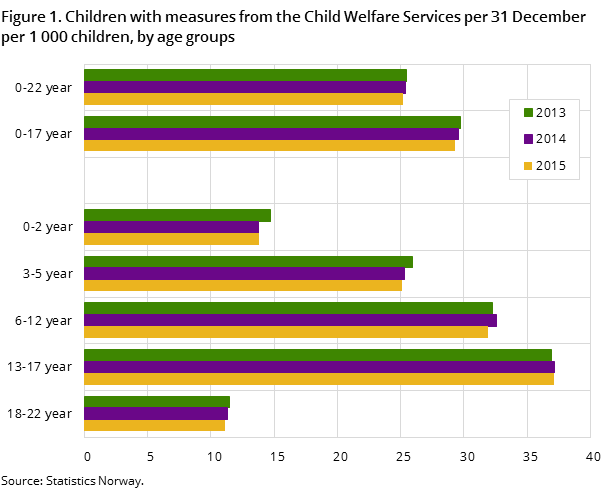
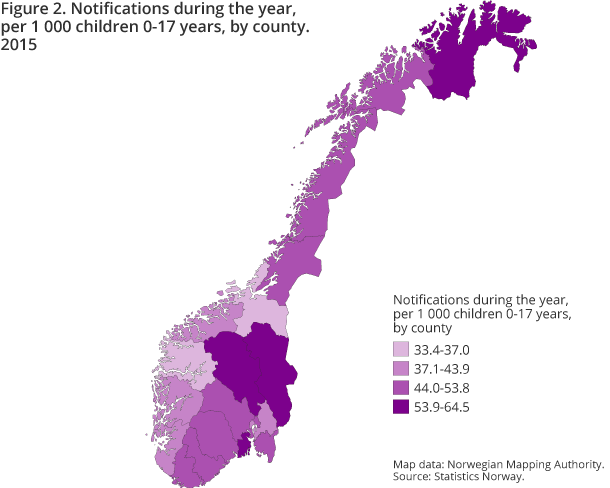
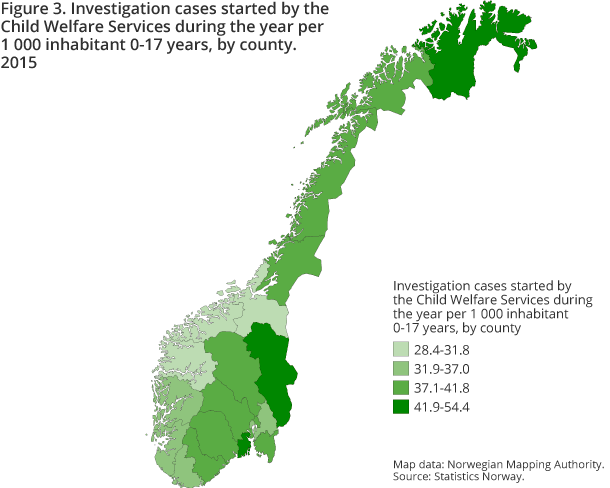
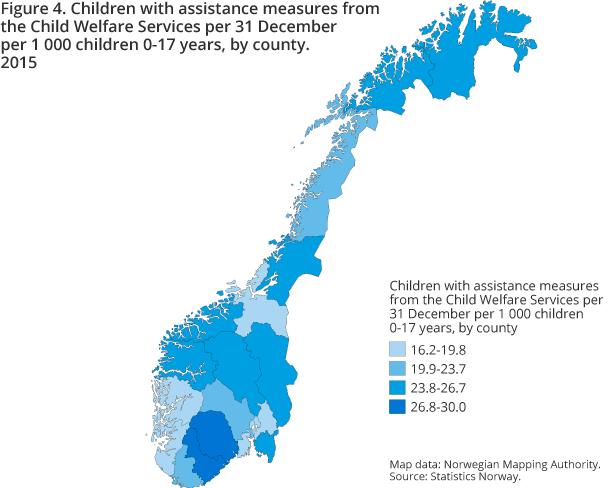
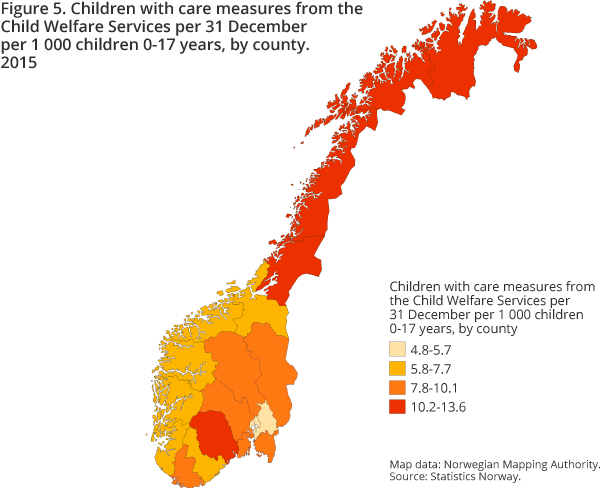
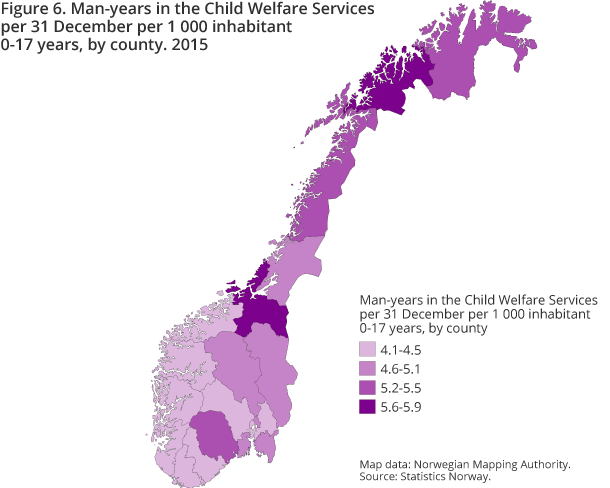
There is an increase in children with care measures in all age groups except among the youngest children, age 0-2 years, were there has been a decrease.
The proportion of children aged 0-17 years with care measures has also increased, from 6.3 per 1 000 children in 2010 to 7.9 per 1 000 children in 2015. The share of children receiving assistance measures has had an opposite development, from 24.1 child per 1 000 at the end of 2010 to 21.4 per 1 000 children at the end of 2015.
Small increase in the number of children receiving measures during the year
A total of 53 440 children received measures from the Child Welfare Services during 2015; an increase of 350 children. In 2014, the number was 53 090. In 2015, 81 per cent of the children received assistance measures and 19 per cent received care measures; an increase from 17 per cent in 2013.
As in previous years, there were more boys than girls receiving assistance from the Child Welfare Services in 2015; a share of 55 per cent boys.
7 in 10 with placement measures are in foster homes
By the end of 2015, about 36 800 children were registered with measures from the Child Welfare Services, which is 300 fewer than in 2014.
More than 40 per cent of the children with measures at the end of the year were placed outside of their family home, either as a care or an assistance measure. About 14 850 children were placed, which is about the same as in 2014. Foster homes covered 7 out of 10 of the placement measures.
Increase in number of notifications
In 2015, the Child Welfare Services concluded 54 400 notifications relating to 48 330 children. This is 3 per cent more than in 2014. The clear majority of the notifications were processed and concluded within the deadline of 7 days, with less than 2 per cent having a longer processing time.
A total of 43 690 of the notifications, 80 per cent, were submitted for further investigation, and the rest of the notifications were dismissed.
43 680 investigations initiated
In 2015, the Child Welfare Services initiated 43 680 investigations on 40 950 children; an increase of just over 4 per cent since 2014.
Rise in investigations closed
The Child Welfare Services closed 44 100 investigations in 2015; an increase of almost 8 per cent compared to 2014. In 2015, 40 per cent of the closed investigations had a decision on starting measures. In 1.5 per cent of the investigations, an application was submitted for measures to the county welfare board. The rest of the investigations were dismissed for various reasons; 46 per cent after assessment by the child welfare service, 8 per cent at the parties' request and 5 per cent due to relocation.
Most measures are aimed at enhancing the child's development
The number of measures by the end of 2015 was approximately 81 200, which is 1 530 fewer than in 2014. From the eight main categories, where three of them contained placement measures, 38 per cent were measures to enhance the child's development. Twenty-six per cent of the measures were measures to enhance parenting skills.
NOK 11.8 billion total expenditure
The total expenditure for the Child Welfare Services grew by more than NOK 500 million from 2014, and totalled NOK 11.8 billion in 2015, representing a 5 per cent rise.
Increase in man-years in the Child Welfare Services
A total of 5 296 man-years were reported by the end of 2015; an increase of 3 per cent compared to 2014. The largest group of man-years is made up of child-care workers by occupation, with 2 537 man-years. A total of 1 546 man-years is made up of social workers by occupation.
From notification through investigation to measuresOpen and readClose
A case often starts with a notification to Child Welfare Services, which as soon as possible and within a week must decide whether they should initiate an investigation or close the notification. An investigation starts as soon as possible and a decision must be made within three months on whether measures should be started or the case should be closed.
Changed reporting systemOpen and readClose
A new reporting system was introduced in 2013, which entails changes in how and what is being reported to Statistics Norway. A few municipalities did not report for 2013. This means that comparisons with previous and later years should be made with care. The municipality of Røst has not reported for 2015.
Contact
-
Tone Dyrhaug
E-mail: tone.dyrhaug@ssb.no
tel.: (+47) 40 90 24 20
-
Unni Beate Grebstad
E-mail: unni.grebstad@ssb.no
tel.: (+47) 94 50 68 66
